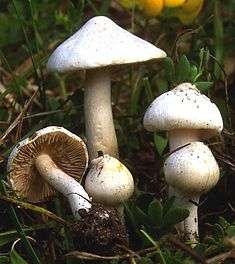Inocybe geophylla
| Inocybe geophylla | |
|---|---|
 | |
| Very Common | |
| Scientific classification | |
| Kingdom: | Fungi |
| Phylum: | Basidiomycota |
| Class: | Basidiomycetes |
| Order: | Agaricales |
| Family: | Inocybaceae |
| Genus: | Inocybe |
| Species: | I. geophylla |
| Binomial name | |
| Inocybe geophylla (Pers.) P. Kumm. | |
| Inocybe geophylla | |
|---|---|
|
| |
| gills on hymenium | |
|
cap is umbonate or conical | |
| hymenium is adnexed | |
| stipe is bare | |
| spore print is brown | |
| ecology is mycorrhizal | |
|
edibility: poisonous or deadly | |
Inocybe geophylla, commonly known as the earthy inocybe, common white inocybe or white fibercap, is a poisonous mushroom of the genus Inocybe. It is widespread and common in Europe and North America, appearing under both conifer and deciduous trees in summer and autumn. The fruiting body is a small all-white or cream mushroom with a fibrous silky umbonate cap and adnexed gills. An all-lilac variety lilacina is also common.
Taxonomy and naming
It was first described as Agaricus geophyllus by mycologist Christian Hendrik Persoon in 1801, before being given its current binomial name in 1871 by Paul Kummer. Its specific epithet is derived from the Ancient Greek terms geo- “earth”, and phyllon “leaf”.[1] A lilac form is known as var. lilacina; it was originally described as Agaricus lilacinus by American mycologist Charles Horton Peck in 1872, before being given its current name by Claude Casimir Gillet in 1876.
Description
The cap is 1–4 cm (0.4–2.6 in) in diameter and white or cream-coloured with a silky texture, at first conical before flattening out to a more convex shape with a pronounced umbo (boss). The cap margins may split with age. The thin stipe is 1–6 cm (0.4–2.4 in) high and 0.3–0.6 cm thick and lacks a ring. The crowded gills are adnexed and cream early, before darkening to a brownish colour with the developing spores. The spore print is brown. The almond-shaped spores are smooth and measure around 9 × 5 μm. The faint smell has been likened to meal,[2] damp earth,[1] or even described as spermatic.[3]
The variety lilacina is similar in shape but tinted lilac all over, with an ochre-brown flush on the cap umbo and the base of the stem. It has a strong mealy or earthy odour.[2] This variety could be mistaken for the edible amethyst deceiver (Laccaria amethystina), although the latter species has a fibrous stipe, a fruity smell and lacks the ochre-coloured umbo.[4]
Distribution and habitat

Inocybe geophylla is common and widespread across Europe and North America.[2][3] It is mycorrhizal, the fruiting bodies are found in deciduous and coniferous woodlands in summer and autumn. Within these locations, fruiting bodies may be found in grassy areas and near pathways,[5] or often on rich, bare soil that has been disturbed at roadsides, and near ditches.[6]
In Western Australia, Matheny & Bougher (2005) point to collections of what was referred to as I. geophylla var. lilacina by some Australian taxonomists, as a misapplication of the name I. geophylla var. lilacina; the specimens have been reclassified as the species Inocybe violaceocaulis.[7]
Toxicity
Like many fibrecaps, Inocybe geophylla contains muscarine.[8] The symptoms are those of muscarine poisoning, namely, greatly increased salivation, perspiration (sweating), and lacrimation (tear flow) within 15–30 minutes of ingestion. With large doses, these symptoms may be followed by abdominal pain, severe nausea, diarrhea, blurred vision, and labored breathing. Intoxication generally subsides within two hours.[9] Delirium does not occur. The specific antidote is atropine. Inducing vomiting to remove mushroom contents is also prudent due to the speed of onset of symptoms.[10] It is also dangerous to dose atropine, as that itself, can cause toxicity and death with too large or repeated doses.
Death has not been recorded as a result of consuming this species. It is often ignored by mushroom hunters because of its small size.[5]
See also
References
- 1 2 Nilson, Sven; Olle Persson (1977). Fungi of Northern Europe 2: Gill-Fungi. Penguin. p. 98. ISBN 0-14-063006-6.
- 1 2 3 Phillips, Roger (1981). Mushrooms and Other Fungi of Great Britain and Europe. London: Pan Books. p. 220. ISBN 0-330-26441-9.
- 1 2 David Arora (1986). Mushrooms Demystified. Ten Speed Press. p. 460. ISBN 0-89815-169-4.
- ↑ Lamaison, Jean-Louis; Polese, Jean-Marie (2005). The Great Encyclopedia of Mushrooms. Könemann. p. 83. ISBN 3-8331-1239-5.
- 1 2 Haas, Hans (1969). The Young Specialist looks at Fungi. Burke. p. 122. ISBN 0-222-79409-7.
- ↑ Thomas Laessoe (1998). Mushrooms (flexi bound). Dorling Kindersley. ISBN 0-7513-1070-0.
- ↑ Matheny PB, Bougher NL (2004). "A new violet species of Inocybe (Agaricales) from Urban and Rural Landscapes in Western Australia". Australasian Mycologist. 24 (1).
- ↑ Benjamin, Denis R. (1995). Mushrooms: poisons and panaceas – a handbook for naturalists, mycologists and physicians. New York: WH Freeman and Company. p. 343. ISBN 0-7167-2600-9.
- ↑ North, Pamela (1967). Poisonous Plants and Fungi in colour. Blandford Press & Pharmacological Society of Great Britain. p. 111.
- ↑ Benjamin, p. 346–49.